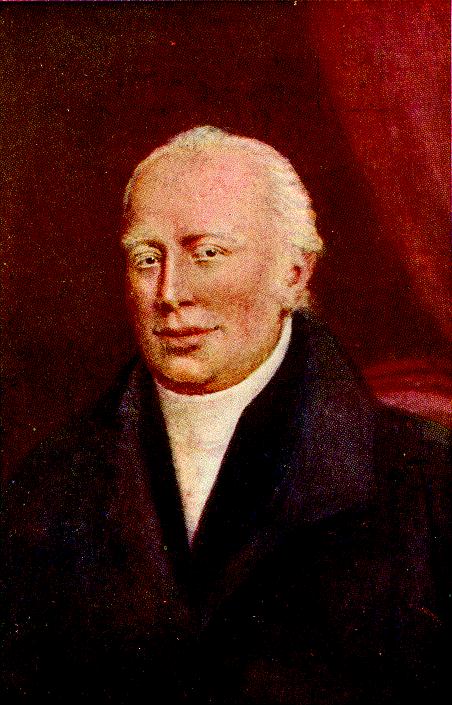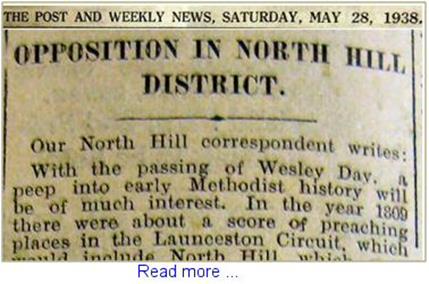


METHODISM
The Methodist movement is a group of historically related denominations of Protestant Christianity which derive their inspiration from the life and teachings of John Wesley, pictured right. It originated as a revival movement within the 18th century Church of England and became a separate denomination after Wesley's death. Wesley's theology focused on sanctification and the effect of faith on the character of a Christian. Distinguishing Methodist doctrines include the new birth, an assurance of salvation, imparted righteousness, the possibility of perfection in love, the works of piety, and the primacy of Scripture. Most Methodists teach that Jesus Christ, the Son of God, died for all of humanity and that salvation is available for all. |
||||
Adam Clarke (c1760-1832)
Adam Clarke, pictured here in later years, was a young looking 21 year old but intelligent and popular; "his labours were abundantly owned of God; conversions were numerous and the Church was strengthened". Around this time he was on his way from Liskeard to Launceston and met a farmer named John Nile, the then owner of South Botternell which was just in Linkinhorne parish, a few yards from the boundary with North Hill parish. South Botternell has long since been demolished but was located on the corner of the B3254 and the road leading to Blackcoombe Farm (click here for a Google map location). He allowed Clarke to preach at Botternell and later at Battens which was John Nile’s home after he moved from Botternell. Adam's son was was the Reverend James Bulmer Butterwoth Clarke (c1800-1855) whose obituary reads as follows: Adam's grandadughter, the daughter of The Reverend J B B Clarke was Dora Madelaine Hoare Clarke. She was born in 1852 and married on 22nd September 1875 to Edward Stanhope Rodd of Trebartha Hall, North Hill. Exactly two months after their marriage Dora died at Mentone on the French Riviera. Edward remarried in 1879 to Annie Stuart King. |
The Story of the Conversion of John NileNile himself was not converted at that first service at Botternell, but was so deeply affected, that he was unable to sleep. He arose from his bed and walked over his farm during the night, and prayed to the Lord to forgive his sins. Presently he approached the turnip field, and there he saw a figure stooping down on the ground. He watched a moment and then discovered it was a man stealing his turnips, and putting them in a sack. Mounting the hedge he cried; “Hallo there! what are ee about?" The man, aware that he was caught, cried out “Oh maaster! do ee forgive me; forgive me this once, maaster." "Forgive ee!" said Nile drawing near to the man, “Why that's what I want the Lord to do for me, I want the Lord to forgive me, and I must forgive thee." In that moment he obtained the blessing. He forgave his brother and his Heavenly Father also forgave him. Then said he, lifting up the sack on the man's head, "Take the turnips and go home with mun, but dont ee steal any more. If ee want any again come to me, and I'll give mun to ee.“ [From: James Venning - An illustrated postal directory with map and historical notices, of twenty parishes in East Cornwall, for the new century. From A.D. 449 to 1901.] |
Molly Nile’s mistakeOn one occasion when Adam Clarke was due to preach at Batten’s Farm the farmer’s wife Mary (known as Mollie) Nile prepared something special for Adam Clarke’s supper, as was her custom. She took great care of the preachers who came to her home. On this occasion she carefully cut some dainty slices of beef from the joint the family had had at dinnertime. She carefully put the beef in the pantry for Adam’s supper, but forgot to properly close the door. The farm cat went in and ate the meat leaving Adam Clarke with no supper. During the same year, Adam Clarke again visited Botternell. One in the congregation, Thomas Jasper of Tremollet, experienced the deliverance described by the preacher. Thereafter he took a leading part in Methodism at North Hill. Adam Clarke paid a third visit to Botternell and again his preaching bore fruit. This time William Downing of Lynher in North Hill became a Methodist. |
William Downing’s Story
Not long after he had become a Methodist, William went out into the field to catch a horse, but the animal eluded his grasp. He swore at the horse and it immediately stood still and was captured but William Downing's conscience began to condemn him. He remained away from class. His leader missed him, sought him out, and asked the reason for his absence from the “Mittins." William was silent. ”What have ee done? Swore at the horse have ee?" "Yes" faltered the young man. “Well”, said his faithful adviser, “if you have sworn at the horse, don’t ee lie there in the dust, get up and run again.“ He did so and from that hour he never faltered. “Uncle Will Downing" as he was afterwards called, became the leader of the Botternell Society when George Brimmell died, and held that post for 50 years. His religious experience was of a high character. He loved the Methodist preachers, and his house at Lynher, North Hill, was the preachers' home. As his end was approaching he would say “I'm not out of gunshot of the enemy, but the world is under my feet and it is no more to me than colours to a blind man." [From: James Venning - An illustrated postal directory with map and historical notices, of twenty parishes in East Cornwall, for the new century. From A.D. 449 to 1901.] |
Chapels
In these early days the places used for worship were spread across the area because there was no established chapel for the Methodists. Batten’s Farm was used for several years. Other places used for worship, preaching and Sunday school were the homes of Richard Peter of Illand and William Wevvil of Trekernel. Richard Peter’s home was used for many years. Until his death in 1823. The venue then moved to Tremollett for a short while before moving again to an empty cottage on the road leading to Penhole. This cottage is the first picture in the header to this page (for a larger image click here). Services were held weekly or fortnightly on Sunday afternoons and the members met in class on Sunday morning under the leadership of Thomas Jasper of Tremollett and later of George Brimmell of Trelabe. In 1810 the building of chapels began and the one in North Hill village (shown above centre) was built. The land upon which it was built was given by Mrs Ann Davey. Thomas Jasper, mentioned above, advanced the money for the purchase of the land and the building of the chapel. A piece of land was acquired and legally conveyed to a body of trustees consisting of:

When the chapel was officially opened crowds came from far and near, many on horseback with their wives riding pillion. The chapel was so full that many had to stand outside. Following renovation costing £85, the North Hill Methodist Chapel was reopened on 21st November 1925 by Mrs E M Downing of Trevadlock. |
The Pethick family and Coad’s Green Methodist ChurchWilliam and Ann Pethick lived with their family at Trebartha Barton in the early 1800s. They had three children baptised in St Torney’s, Mary (1801), Betty (1802) and Thomas (1806). Sadly William died when just 50 years old and was buried in St Torney’s in 1810 whilst there were still young children in the family. The family was split up and Thomas, the youngest was later sent to live with his eldest brother, also named William Pethick, at Lanoy. When Thomas was 11 a revival took place at which many people in the locality were brought to God. This included Thomas and his friend Richard Hicks, who also lived at Lanoy Farm. The two boys organised prayer meetings in the barn but William Pethick forbade any religious services being held on the premises. One day William passed Thomas’ bedroom and heard him praying for William’s conversion. After much thought William decided that there was something in this new form of religion and about the same time he had a dream which brought him to see his sinfulness and also his Saviour. With this he became a sincere Christian and his wife also converted.
When Mr & Mrs Pethick died their remains were placed in the burial ground next to the chapel. William died aged 61 in 1847 and his wife Elizabeth died aged 74 in 1863. There had been an earlier Pethick burial on the site in 1840 when Thomas buried his eighteen month old daughter, Jane. Thomas had been working and living in Bideford but came back to North Hill and married Susan Wevill in St Torney’s in 1830. William Pethick witnessed the marriage as did Matthew Wevill, father of the bride. The wedding took place in St Torney’s because at that time Coad’s Green Church had not been granted a licence to marry people.
In 1868 when the North Hill Circuit was separated from Launceston, Coad’s Green was made the head of the circuit and a minister’s house called “The Manse”, otherwise known as Wesley House, was erected very near the church. The site was granted by Thomas Pethick who contributed largely towards the erection, the cost being roughly £400. After expenditure of over £1000 on the renovation of the church and the rebuilding of the organ Mrs Somerville, the daughter of the late Mr William Petchick of Lanoy reopened it on November 23rd 1923. On December 9th 1944 Coad’s Green Methodist Church was reopened after the installation of new heating apparatus. The full cost of £250 was raised on the day. In the church at Coad’s Green is a marble tablet in the shape of a scroll upon which is inscribed: |
|
|
The images at the top of the page show(l-r):Cottage on Penhole Road; North Hill Methodist Chapel; interior of Coad’s Green Methodist Church |